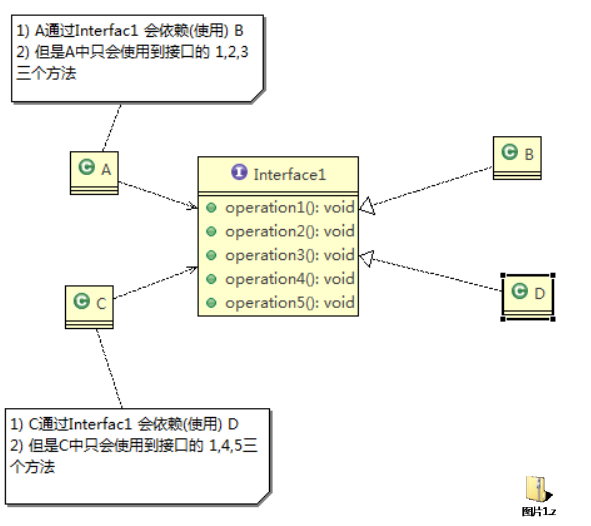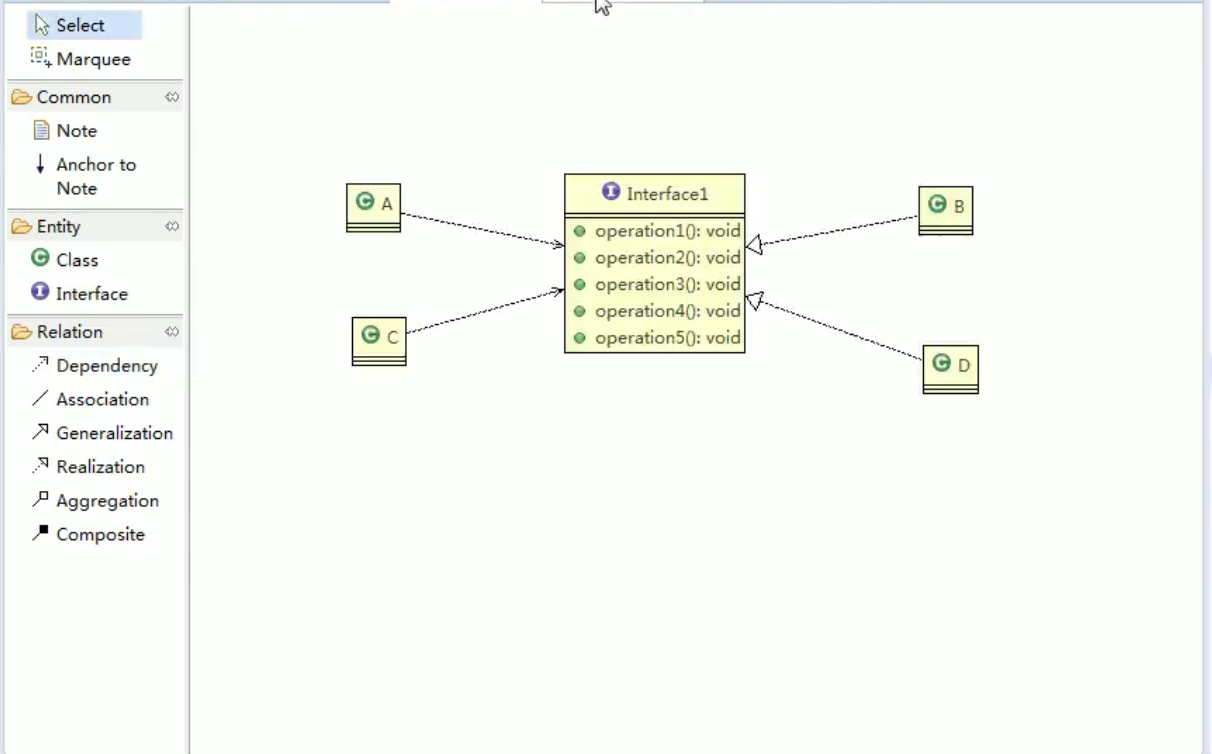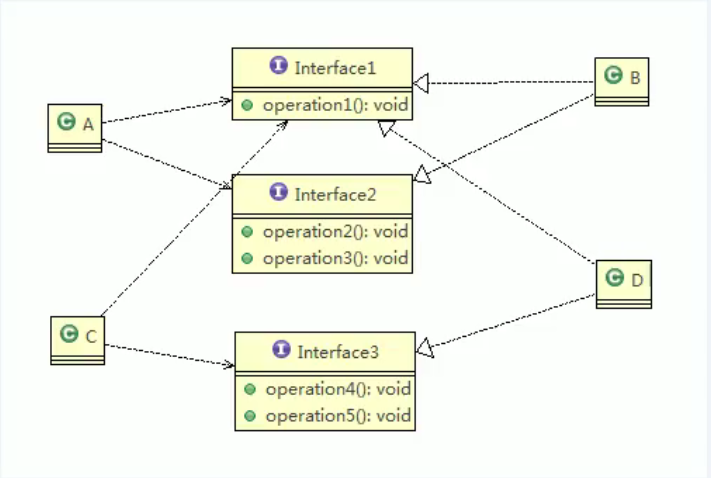1.1 基本介绍
1) 客户端不应该依赖它不需要的接
口,即一个类对另一个类的依赖
应该建立在最小的接口上
2) 先看一张图:
3) 类A通过接口Interface1依赖类B,类C通过
接口Interface1依赖类D,如果接口
Interface1对于类A和类C来说不是最小接口,
那么类B和类D必须去实现他们不需要的方
法。
4) 按隔离原则应当这样处理:
将接口Interface1拆分为独立的几个接口,
类A和类C分别与他们需要的接口建立依赖
关系。也就是采用接口隔离原则
1.2 应用实例
1)类 A通过接口 Interface1依赖类 B,类 C通过接口 Interface1依赖类 D,请编写代码完成此应用实例。
2)看老师代码-没有使用接口隔离原则代码
package com.atguigu.principle.segregation;public class Segregation1 {public static void main(String[] args) {// TODO Auto-generated method stub}}//接口interface Interface1 {void operation1();void operation2();void operation3();void operation4();void operation5();}class B implements Interface1 {public void operation1() {System.out.println("B 实现了 operation1");}public void operation2() {System.out.println("B 实现了 operation2");}public void operation3() {System.out.println("B 实现了 operation3");}public void operation4() {System.out.println("B 实现了 operation4");}public void operation5() {System.out.println("B 实现了 operation5");}}class D implements Interface1 {public void operation1() {System.out.println("D 实现了 operation1");}public void operation2() {System.out.println("D 实现了 operation2");}public void operation3() {System.out.println("D 实现了 operation3");}public void operation4() {System.out.println("D 实现了 operation4");}public void operation5() {System.out.println("D 实现了 operation5");}}class A { //A 类通过接口Interface1 依赖(使用) B类,但是只会用到1,2,3方法public void depend1(Interface1 i) {i.operation1();}public void depend2(Interface1 i) {i.operation2();}public void depend3(Interface1 i) {i.operation3();}}class C { //C 类通过接口Interface1 依赖(使用) D类,但是只会用到1,4,5方法public void depend1(Interface1 i) {i.operation1();}public void depend4(Interface1 i) {i.operation4();}public void depend5(Interface1 i) {i.operation5();}}
1.3 应传统方法的问题和使用接口隔离原则改进
1)类 A通过接口 Interface1依赖类 B,类 C通过接口 Interface1依赖类 D,如果接口 Interface1对于类 A和类 C来说不是最小接口,那么类 B 和类 D 必须去实现他们不需要的方法
2)将接口 Interface1拆分为独立的几个接口,类 A和类 C分别与他们需要的接口建立依赖关系。也就是采用接口隔离原则
3)接口 Interface1 中出现的方法,根据实际情况拆分为三个接口

4)代码实现
package com.atguigu.principle.segregation.improve;public class Segregation1 {public static void main(String[] args) {// TODO Auto-generated method stub// 使用一把A a = new A();a.depend1(new B()); // A类通过接口去依赖B类a.depend2(new B());a.depend3(new B());C c = new C();c.depend1(new D()); // C类通过接口去依赖(使用)D类c.depend4(new D());c.depend5(new D());}}// 接口1interface Interface1 {void operation1();}// 接口2interface Interface2 {void operation2();void operation3();}// 接口3interface Interface3 {void operation4();void operation5();}class B implements Interface1, Interface2 {public void operation1() {System.out.println("B 实现了 operation1");}public void operation2() {System.out.println("B 实现了 operation2");}public void operation3() {System.out.println("B 实现了 operation3");}}class D implements Interface1, Interface3 {public void operation1() {System.out.println("D 实现了 operation1");}public void operation4() {System.out.println("D 实现了 operation4");}public void operation5() {System.out.println("D 实现了 operation5");}}class A { // A 类通过接口Interface1,Interface2 依赖(使用) B类,但是只会用到1,2,3方法public void depend1(Interface1 i) {i.operation1();}public void depend2(Interface2 i) {i.operation2();}public void depend3(Interface2 i) {i.operation3();}}class C { // C 类通过接口Interface1,Interface3 依赖(使用) D类,但是只会用到1,4,5方法public void depend1(Interface1 i) {i.operation1();}public void depend4(Interface3 i) {i.operation4();}public void depend5(Interface3 i) {i.operation5();}}

